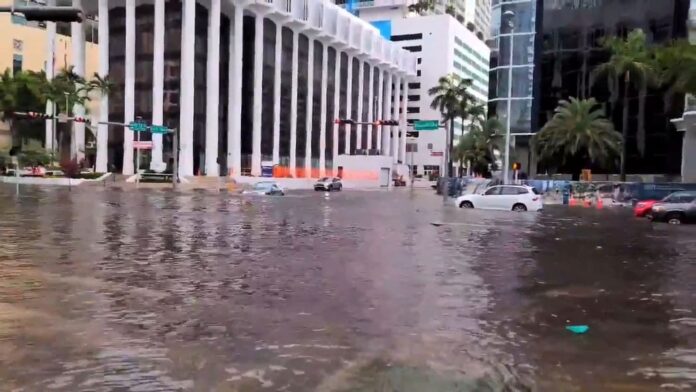The two-day rainfall in Miami was greater than during Hurricane Irma

Rainfall rates briefly topped four inches an hour on Sunday in Miami. (Ryan Rea/Social Media/Reuters)
When Saturday’s rains first arrived in South Florida, they began as a few showers. Then downpours. And over the weekend, the rains didn’t relent. By Saturday, many parts of Miami and surrounding areas were underwater, with streets becoming lagoons as floodwaters rose.
Eight to 10 inches of water fell across a wide swath from Fort Lauderdale to the upper Keys over the holiday weekend, with rainfall in some places the most impressive since Hurricane Irma struck in September 2017.
[A December downpour in Fort Lauderdale dumped 4.45 inches in one hour]
This time around, the instigating system isn’t a tropical storm or hurricane — though it did catch the eye of the National Hurricane Center, which issued a special bulletin noting that it could trigger tropical downpours and flash flooding.
After it slowly pulls away from the Florida coast Tuesday, parts of the coastal Carolinas are next in line, the waterlogged batch of rain slowly churning up the shores of the Southeast.
The heavy rains in Florida

Storm clouds over Florida on Monday, as heavy downpours hit the state. (RAMMB/CIRA)
Light rain first started falling over Miami late on Saturday afternoon. But once the clock hit 8 a.m. Sunday, the skies opened up: 2.51 inches poured down at the airport within three hours, including 1.36 inches in just an hour. Rainfall rates briefly topped four inches an hour as vigorous tropical deluges parked over the state’s second-largest city.
Continued heavy rains lasted through Memorial Day, a total of 7.27 inches recorded over a 48-hour window. Significant flash flooding inundated the city, hitting the Brickell neighborhood particularly hard and backing up drainage and sewer systems.
It was Miami’s heaviest two-day rainfall since 2012, beating out what fell during Irma.
An EF1 tornado even spun up shortly before 2 a.m. Monday near the Redlands in central Miami-Dade County.
[Thunderstorms could scrub historic SpaceX launch of two NASA astronauts on Wednesday]
Totals reach double digits in some spots
The drenching made it as far north as the Treasure Coast, where a 48-hour rainfall accumulation of 10.44 inches was noted in Tequesta. Nearby Jupiter reported 8.89 inches, while a spotter northwest of Miami measured 8.33 inches in two days.
Brian McNoldy, Capital Weather Gang’s tropical weather expert, reported 8.29 inches during that window, bringing May’s total to 18.13 inches for the month to date. Average May rainfall is 5.34 inches.
Ordinarily, the rainfall would be good news for drought-stricken Florida, which saw its driest March on record, but having all the water come down at once is a recipe for trouble.
“Previously, we were in moderate drought for the area,” said Paxton Fell, a meteorologist with the National Weather Service in Miami. “All this rainfall definitely helped, but since we’re so saturated, the ground can’t handle much.”
Land use and climate change played a role

Roads are inundated in Miami on Monday. (Ryan Rea/social media/Reuters)
The urban construction of Miami helped to exacerbate problems, with impermeable cement and concrete trapping water like a giant tarp.
“Miami is basically a concrete jungle,” Fell said. “It was raining so heavily for so long that sewers and drains and everything got backed up. There was a lot of back-building and training [with those cells].”
Exceptional atmospheric moisture drawn northwestward by the tropical system provided a constant source of “juice” for storms to tap into, replenishing their ability to rain almost indefinitely thanks to the onshore wind fetch.

With six inches of sea-level rise since 1996, Miami is in dire straits as flood events increase in frequency disproportionately. (Matthew Cappucci/The Washington Post)
“It was a weak [trough of low pressure] that set up to our south, and we had persistent southeasterly flow going on, bringing its own moisture onto the area,” Fell said. “So when this system kind of moved through, it just increased our [atmospheric moisture content] pretty much to … our maximum percentile.”
Fell said that the flooding experienced in Palm Beach and Broward counties was primarily due to the heavy rainfall but that elevated seas played a bit of a role in downtown Miami thanks to the onshore fetch.
Saltwater coastal flooding is becoming increasingly common in Miami because of rising sea levels. Since 1996, sea levels there have risen 5.9 inches, more than tripling the frequency with which the city sees at least nuisance flooding. “Action” tier flooding is now 12 times as common.
[Sea level rise is combining with other factors to regularly flood Miami]
And when heavy rains conspire with high tides, the combined effects will continue to become even more significant into the future.
While the rains have finally abated for Florida, a flood watch remained in effect Tuesday for the greater Miami and Fort Lauderdale areas. A possibility of isolated afternoon showers and thunderstorms presented the threat of sporadic renewed flooding.
Next in line: The Carolinas

The timing of heavy rainfall as it moves into the Carolinas on Wednesday, as simulated by the NAM model. Note the interesting circular structure of the storm, pointing to its tropical nature. Heavy rain will accompany the inner bands, while a few tornadoes are possible to the east. (WeatherBell)
Meanwhile as the system departs Florida, the Carolinas are eyeing the potential for heavy rainfall. Areas of moderate to locally heavy rain were already forming across the coastal plain of the Carolinas early Tuesday, and that rain will increase in both coverage and intensity throughout the day in the tropical air ahead of the system.
After a lull late Tuesday, the system looks to arrive near the North Carolina-South Carolina state line around sunrise Wednesday, bringing an eight- to 10-hour period of heavy rain and downpours. A widespread two to three inches is possible, with localized four-inch-plus amounts.

Rainfall forecast through Friday morning from the National Weather Service.
It’s important to stress that the band of heaviest rain may be only about 50 to 100 miles wide, with rainfall totals tapering off rapidly along the periphery.
There may also be some enhancement within feeder bands that could affect the Outer Banks. A nonzero tornado threat also will be present within a couple of these bands.
Elsewhere, scattered downpours are possible across the Mid-Atlantic on Wednesday, though a washout is not expected. As a result, rainfall totals will be highly irregular.
The system’s remnants will weaken and dissipate over the Northeast into Thursday, with more pleasant weather building in across the Southeast and Mid-Atlantic late in the week.






